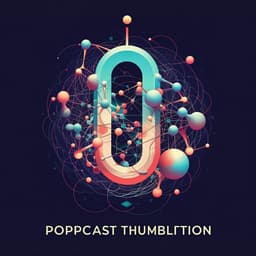
Physics
Anti-Zeno quantum advantage in fast-driven heat machines
V. Mukherjee, A. G. Kofman, et al.
This groundbreaking research by Victor Mukherjee, Abraham G. Kofman, and Gershon Kurizki reveals how a fast-modulated cyclic quantum heat machine operating in the non-Markovian regime utilizes the anti-Zeno effect to enhance heat current and power, offering remarkable quantum advantages over traditional machines. Discover how this innovative approach takes advantage of the time-energy uncertainty relation, leading to more efficient energy exchange.
Playback language: English
Introduction
The quest for quantum machines outperforming their classical counterparts is a central theme in quantum thermodynamics and technologies. The field's theoretical description of quantum heat machines (QHMs) predominantly relies on the Markovian approximation, which simplifies the system-bath interaction by assuming the bath's memory effects are negligible. This approximation implies monotonic convergence to thermal equilibrium and imposes universal bounds on entropy production. However, while the Markovian approximation isn't necessary for deriving the Carnot efficiency bound for a cyclic two-bath heat engine, the question of whether non-Markovianity offers advantages remains largely open. Previous research has explored potential quantum advantages using resources like coherently superposed bath atoms or squeezed thermal baths. These approaches, however, don't demonstrate distinctly quantum mechanisms, as classical analogs might exist. Quantum coherent or squeezed driving, while boosting power output, doesn't rely on intrinsically quantum features. This paper challenges this prevailing notion by demonstrating a genuinely quantum advantage in a QHM operating beyond the Markovian regime. This advantage stems from harnessing the anti-Zeno effect, a phenomenon where frequent interactions with the bath accelerate energy exchange, contrasting with the quantum Zeno effect which slows down such exchange. The authors propose that by exploiting the anti-Zeno effect, a substantial power boost is possible without compromising the Carnot efficiency bound, thus presenting a significant advancement in quantum thermodynamics.
Literature Review
Existing literature on quantum thermodynamics predominantly focuses on the Markovian regime, using the Markovian approximation to model system-bath interactions. While this simplifies analysis, it neglects the memory effects inherent in realistic systems. Studies exploring non-Markovian effects have emerged, focusing on efficiency and power. Some studies suggest that quantum resources, such as entanglement in the bath or squeezed thermal baths, could potentially enhance the efficiency beyond the Carnot limit. However, the mechanisms responsible for these enhancements are not entirely quantum, often possessing classical analogs. This paper directly addresses the open question of whether non-Markovianity itself can provide a distinct quantum advantage in QHM performance beyond the enhancements offered by quantum resources or driving.
Methodology
The researchers model a QHM using a quantum system (working fluid, WF) coupled to hot and cold thermal baths. The WF's energy-level gap is periodically modulated with a period τs. To ensure frictionless dynamics, the time-dependent Hamiltonian Hs(t) is chosen to be diagonal in the energy basis, ensuring commutation at all times. The system interacts with the baths via a Hamiltonian involving system and bath operators. Crucially, the rotating wave approximation is not used, allowing for a more comprehensive treatment of the system-bath interaction. The baths are assumed to have non-overlapping spectra, a condition enabling intermittent coupling to one bath or the other during modulation, without modifying the interaction Hamiltonian. The researchers analyze the dynamics in the transition from Markovian to non-Markovian timescales by decreasing the modulation period τs, employing a Floquet expansion of the Liouville operator to account for the periodicity of Hs(t). This allows the examination of system-bath coupling durations τC of the order of a few modulation periods. The key time scales considered include the modulation period τs, the system-bath coupling duration τC, the bath correlation time τb, and the thermalization time τth. For weak system-bath coupling (Born approximation), the analysis focuses on the regime where τs is less than or equal to τb, rendering the Markov approximation inapplicable. This leads to a fast-modulation form of the master equation, which involves a convolution of the bath spectral response function and a sinc function arising from the time-energy uncertainty relation. The anti-Zeno effect is explored by examining the overlap between the sinc function and the bath's spectral response function. The QHM operates in two-stroke cycles: a coupling stroke with the system interacting with both baths for n modulation periods and a decoupling stroke where the system is decoupled to eliminate memory effects. A two-level system (TLS) WF is considered as an example, with its resonance frequency sinusoidally modulated. The spectral functions of the hot and cold baths are chosen to satisfy specific conditions ensuring that positive sidebands couple only to the hot bath and negative sidebands only to the cold bath. The KMS condition and the assumption of symmetric bath spectral functions around a central frequency are utilized to simplify the analysis. The steady-state heat currents and power are calculated to analyze the performance of the QHM under different modulation frequencies. Quasi-Lorentzian and super-Ohmic bath spectral functions are used as examples. The Markovian limit is obtained by replacing the sinc function with a delta function in the master equation. The efficiency and coefficient of performance are evaluated in both the Markovian and non-Markovian regimes. Analysis includes consideration of the overlap between sinc functions and spectral functions for various modulation rates to analyze the anti-Zeno effect's contribution.
Key Findings
The study's central finding is the demonstration of a quantum advantage in a QHM operating in the non-Markovian regime, specifically due to the anti-Zeno effect. This effect leads to a significant enhancement of the power output without altering the efficiency, which remains bounded by the Carnot limit. The power boost is directly linked to the interplay between the time-energy uncertainty principle and the bath's spectral response function. Fast modulation broadens the sinc function in the master equation, enhancing the overlap with the bath spectral function and thereby increasing the energy exchange rates. This enhancement is most pronounced when the bath spectral functions are sufficiently detuned from the central frequency of the system, indicating a tunable aspect of the quantum advantage. Numerical simulations using quasi-Lorentzian and super-Ohmic bath spectral functions confirm this power boost, demonstrating an enhancement factor of more than two and seven respectively. The anti-Zeno effect was shown not only to enhance heat engine performance but also quantum refrigeration. In the refrigerator regime, fast modulation similarly enhances the heat current and the cooling rate, showing a factor of two to nine increase for the respective bath spectral functions. Importantly, the coefficient of performance in the refrigerator regime remains unaffected by the modulation rate, similar to the heat engine's efficiency. The Markovian approximation, while accurately predicting efficiency and coefficient of performance even in the non-Markovian regime for symmetric spectral functions, fails to capture the power boost, emphasizing the significance of the non-Markovian treatment. The research highlights that non-Markovian dynamics itself doesn’t automatically imply a quantum advantage; the specific nature of the bath's spectral function and its overlap with the modulated system are crucial. The paper explicitly analyzes the conditions under which the quantum advantage is maximized in both heat engine and refrigerator scenarios, showing that this enhancement results from enhanced relaxation rates arising from the TLS interaction with the baths. The time-energy uncertainty is highlighted as the key quantum mechanical feature that distinguishes this enhancement from classical non-Markovian dynamics.
Discussion
This research provides compelling evidence for a genuine quantum advantage in QHMs operating beyond the Markovian approximation. The observed power boost, arising from the anti-Zeno effect, is a direct consequence of the time-energy uncertainty relation, a purely quantum mechanical phenomenon. This effect allows for a faster energy exchange between the system and the baths, which increases power output without compromising the fundamental efficiency limits set by thermodynamics. The finding challenges the conventional wisdom that suggests quantum advantages in QHMs are primarily tied to quantum resources or specific bath properties. Instead, this work demonstrates that the non-Markovian nature of the system-bath interaction itself can be a source of quantum enhancement. This opens up new avenues for designing high-performance QHMs by carefully controlling the modulation rate and system-bath coupling to maximize the overlap between the sinc function and the bath spectral function. The results are particularly relevant for experimental implementations using systems with non-flat bath spectral functions, such as superconducting qubits or NV centers, providing specific experimental parameters for realizing this quantum advantage. The research also has implications for understanding the third law of thermodynamics in the non-Markovian quantum regime, raising questions about the validity of the principle in these circumstances.
Conclusion
This paper successfully demonstrates a quantum advantage in quantum heat machines through the exploitation of the anti-Zeno effect in the non-Markovian regime. The findings highlight a novel pathway for designing more efficient heat machines by manipulating the system-bath interaction's temporal dynamics. Future research could focus on exploring other types of quantum thermal machines, extending the analysis to more complex systems and bath spectral functions, and investigating the potential implications for low-temperature refrigeration.
Limitations
The study's primary focus is on the idealized model of a QHM with specific assumptions about the bath spectral functions. Real-world systems may deviate from these idealizations, impacting the observed quantum advantage. The analysis is also restricted to weak system-bath coupling, and the extent to which the results hold for stronger coupling requires further investigation. The specific two-stroke model employed may not be optimal; further optimization of the cycle design could potentially lead to even greater power enhancements. Finally, experimental challenges exist in controlling and maintaining the required modulation speed and system-bath coupling with high precision.
Related Publications
Explore these studies to deepen your understanding of the subject.







